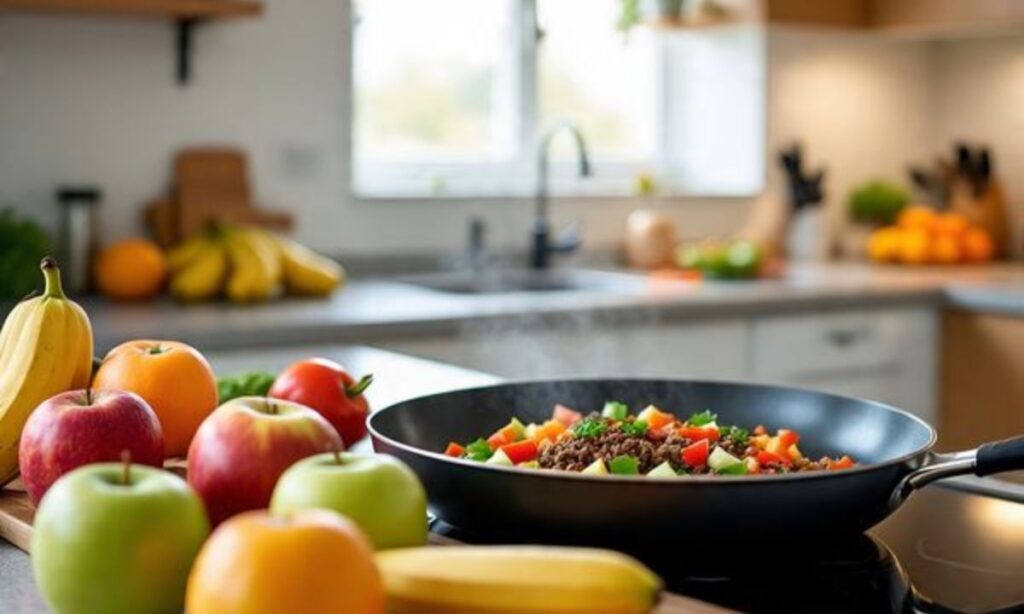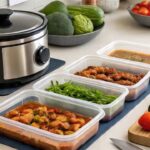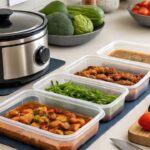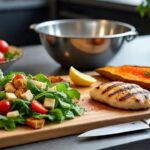Inflammation is the body’s natural response to injury or infection, but chronic inflammation can contribute to health issues like heart disease, arthritis, and diabetes. One effective way to fight inflammation is by eating anti-inflammatory foods. Meal prepping with the right ingredients can help you maintain consistency, save time, and improve overall health.
This guide covers practical anti-inflammatory meal prep ideas, tips, and a sample plan to get you started.
Why Focus on Anti-Inflammatory Meal Prep?
- Consistency: Prepping meals ahead of time ensures you’re always ready with healthy options.
- Better Food Choices: Reduces the temptation to reach for processed or inflammatory foods.
- Time-Saving: Streamlines your weekly cooking schedule.
- Health Benefits: Promotes a healthy weight, reduces chronic inflammation, and boosts immunity.
Key Anti-Inflammatory Foods to Include
Here are some must-have items for your grocery list:
- Fruits: Berries, oranges, cherries, and grapes.
- Vegetables: Leafy greens (spinach, kale), broccoli, cauliflower, and peppers.
- Whole Grains: Brown rice, quinoa, oats, and barley.
- Healthy Fats: Olive oil, avocado, chia seeds, and walnuts.
- Proteins: Salmon, sardines, beans, tofu, and chicken breast.
- Herbs & Spices: Turmeric, ginger, garlic, and cinnamon.
Sample Anti-Inflammatory Meal Prep Plan
| Day | Breakfast | Lunch | Dinner | Snack Ideas |
|---|---|---|---|---|
| Monday | Overnight oats with blueberries & chia | Quinoa salad with kale and chickpeas | Baked salmon with steamed broccoli | Apple slices with almond butter |
| Tuesday | Green smoothie (spinach, banana, ginger) | Lentil soup with turmeric and carrots | Grilled chicken with brown rice | Mixed nuts with dark chocolate |
| Wednesday | Greek yogurt with berries & flaxseeds | Sweet potato & black bean Buddha bowl | Stir-fried tofu with vegetables | Hummus with cucumber sticks |
| Thursday | Avocado toast with whole-grain bread | Sardine salad with olive oil dressing | Shrimp stir-fry with quinoa | Fresh orange slices |
| Friday | Oats with cinnamon & walnuts | Mediterranean chickpea salad | Baked cod with spinach and tomatoes | Green tea with pumpkin seeds |
Anti-Inflammatory Meal Prep Tips
- Batch Cooking: Prepare proteins (salmon, chicken, tofu) and grains (quinoa, rice) ahead of time.
- Use Glass Containers: Store meals in airtight glass containers to maintain freshness.
- Incorporate Color: Aim for a rainbow of fruits and vegetables for maximum antioxidants.
- Season Naturally: Replace heavy sauces with spices like turmeric, ginger, and garlic.
- Healthy Snacks: Prep small bags of nuts, seeds, and fruit to fight mid-day cravings.
- Stay Hydrated: Include herbal teas and water-rich foods like cucumbers in your routine.
Easy Anti-Inflammatory Meal Prep Ideas
Breakfast
- Chia seed pudding with almond milk, turmeric, and berries.
- Smoothie bowls with spinach, avocado, and flaxseeds.
- Oatmeal topped with cinnamon, apples, and walnuts.
Lunch
- Quinoa and chickpea salad with lemon-olive oil dressing.
- Lentil and turmeric soup with whole-grain toast.
- Salmon salad with spinach, avocado, and pumpkin seeds.
Dinner
- Baked salmon with roasted Brussels sprouts and sweet potatoes.
- Chicken and vegetable stir-fry with ginger and garlic.
- Tofu curry with turmeric, coconut milk, and brown rice.
Snacks
- Fresh berries with Greek yogurt.
- Carrot sticks with hummus.
- Green tea with a handful of almonds.
Benefits of an Anti-Inflammatory Diet
- Reduces joint pain and swelling.
- Supports heart health and lowers cholesterol.
- Enhances digestion and gut health.
- Improves energy levels and mental clarity.
- Promotes weight management and satiety.
FAQs about Anti-Inflammatory Meal Prep
Q1. How long can anti-inflammatory meals last in the fridge?
Most anti-inflammatory meal preps can last 3–4 days in the fridge when stored in airtight containers.
Q2. Can I freeze anti-inflammatory meals?
Yes. Meals like soups, stews, and baked proteins can be frozen for up to 2–3 months.
Q3. What are the best spices for reducing inflammation?
Turmeric, ginger, cinnamon, and garlic are some of the most powerful anti-inflammatory spices.
Q4. Is it expensive to eat an anti-inflammatory diet?
Not necessarily. Buying seasonal produce, bulk grains, and affordable protein sources like beans and lentils can keep costs low.
Q5. Can I follow an anti-inflammatory diet if I’m vegetarian or vegan?
Absolutely. Focus on plant-based proteins like lentils, beans, tofu, and seeds while incorporating lots of colorful vegetables and healthy fats.
Final Thoughts
Anti-inflammatory meal prep is a powerful way to take control of your health, reduce chronic inflammation, and simplify your weekly cooking routine. By incorporating whole foods, healthy fats, and anti-inflammatory spices into your meals, you’ll nourish your body and boost your long-term well-being.
Start small with a few recipes, plan your grocery list, and build a prep routine that works for you.





